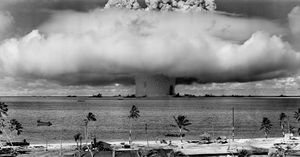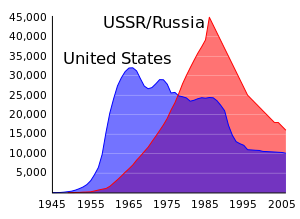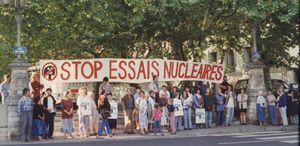نزع السلام النووي
نزع السلاح النووي Nuclear disarmament، هو إجراء لتقليل أو التخلص من الأسلحة النووية. ويمكن أن تكون أيضاً الحالة النهائية لعالم خالي من الأسلحة النووية، حيث يتم القضاء على الأسلحة النووية تماماً. كما يستخدم مصطلح نزع السلاح النووي لوصف العملية المؤدية إلى نزع السلاح النووي بالكامل.[2][3]
تشمل جماعات نزع الأسلحة النووية حملة نزع السلاح النووي، حراك السلام، السلام الأخضر، سوكا گاكاي الدولي، الأطباء الدوليون لمنع الحرب النووية، عمد من أجل السلام، گلوبال زيرو، الحملة الدولية للتخلص من الأسلحة النووية، ومؤسسة سلام العصر النووي. كان هناك العديد من المظاهرات الاحتجاجات الضخمة المناهضة للأسلحة النووية. في 12 يونيو 1982، تظاهر مليون شخص في سنترال پاراك بمدينة نيويورك ضد الأسلحة النووية ومن أجل إنهاء سباق التسلح في الحرب الباردة. كانت أكبر مظاهرة مناهضة للأسلحة النووية وأكبر مظاهرة سياسية في التاريخ الأمريكي.[4][5]
في السنوات الأخيرة، يدعو بعض رجال الدولة الكبار بالولايات المتحدة لنزع الأسلحة النووية. دعا سام نون، وليام پري، هنري كيسنجر، وجورج شولتز الحكومات لتبني رؤية عالم خالي من الأسلحة النووية، واقترحو ضمن مقالات مختلفة برامج طموحة لاتخاذ خطوات عاجلة من أنجل إنهاء هذا. أسس الأربعة مشروع الأمن النووي من أجل الدفع بهذه الأجندة. وتأسست أيضاً منظمات مثل گلوبال زيرو، مجموعة دولية غير حزبية من 300 قائد عالمي مكرسة لنزع الأسلحة النووية.
يقول أنصار نزع السلاح النووي أنه من شأنه أن يقلل من احتمال نشوب حرب نووية، وخاصة العفوية. ويقول منتقدو نزع السلاح النووي أنه سيقوض الردع.
. . . . . . . . . . . . . . . . . . . . . . . . . . . . . . . . . . . . . . . . . . . . . . . . . . . . . . . . . . . . . . . . . . . . . . . . . . . . . . . . . . . . . . . . . . . . . . . . . . . . . . . . . . . . . . . . . . . . . . . . . . . . . . . . . . . . . . . . . . . . . . . . . . . . . . . . . . . . . . . . . . . . . . . .
التاريخ



حركة نزع الأسلحة النووية

مجلس السلام العالمي
معاهدات الحد من الأسلحة

المعاهدات الأساسية
- Partial Test Ban Treaty (PTBT) 1963: Prohibited all testing of nuclear weapons except underground.
- Nuclear Non-Proliferation Treaty (NPT)—signed 1968, came into force 1970: An international treaty (currently with 189 member states) to limit the spread of nuclear weapons. The treaty has three main pillars: nonproliferation, disarmament, and the right to peacefully use nuclear technology.
- Interim Agreement on Offensive Arms (SALT I) 1972: The Soviet Union and the United States agreed to a freeze in the number of intercontinental ballistic missiles (ICBMs) and submarine-launched ballistic missiles (SLBMs) that they would deploy.
- Anti-Ballistic Missile Treaty (ABM) 1972: The United States and Soviet Union could deploy ABM interceptors at two sites, each with up to 100 ground-based launchers for ABM interceptor missiles. In a 1974 Protocol, the US and Soviet Union agreed to only deploy an ABM system to one site.
- Strategic Arms Limitation Treaty (SALT II) 1979: Replacing SALT I, SALT II limited both the Soviet Union and the United States to an equal number of ICBM launchers, SLBM launchers, and heavy bombers. Also placed limits on Multiple Independent Reentry Vehicles (MIRVS).
- Intermediate-Range Nuclear Forces Treaty (INF) 1987: Created a global ban on short- and long-range nuclear weapons systems, as well as an intrusive verification regime.
- Strategic Arms Reduction Treaty (START I)—signed 1991, ratified 1994: Limited long-range nuclear forces in the United States and the newly independent states of the former Soviet Union to 6,000 attributed warheads on 1,600 ballistic missiles and bombers.
- Strategic Arms Reduction Treaty II (START II)—signed 1993, never put into force: START II was a bilateral agreement between the US and Russia which attempted to commit each side to deploy no more than 3,000 to 3,500 warheads by December 2007 and also included a prohibition against deploying multiple independent reentry vehicles (MIRVs) on intercontinental ballistic missiles (ICBMs)
- Strategic Offensive Reductions Treaty (SORT or Moscow Treaty)—signed 2002, into force 2003: A very loose treaty that is often criticized by arms control advocates for its ambiguity and lack of depth, Russia and the United States agreed to reduce their "strategic nuclear warheads" (a term that remained undefined in the treaty) to between 1,700 and 2,200 by 2012. Was superseded by New Start Treaty in 2010.
- Comprehensive Test Ban Treaty (CTBT)—signed 1996, not yet in force: The CTBT is an international treaty (currently with 181 state signatures and 148 state ratifications) that bans all nuclear explosions in all environments. While the treaty is not in force, Russia has not tested a nuclear weapon since 1990 and the United States has not since 1992.[6]
- New START Treaty—signed 2010, into force in 2011: replaces SORT treaty, reduces deployed nuclear warheads by about half, will remain into force until at least 2021
- Treaty on the Prohibition of Nuclear Weapons—signed 2017, not yet in force: prohibits possession, manufacture, development, and testing of nuclear weapons, or assistance in such activities, by its parties.
Only one country has been known to ever dismantle their nuclear arsenal completely—the apartheid government of South Africa apparently developed half a dozen crude fission weapons during the 1980s, but they were dismantled in the early 1990s.
الأمم المتحدة

السياسة النووية الأمريكية
السياسات النووية الأمريكية المثيرة للجدل
خيارات السياسة الأمريكية للإرهاب النووي
دول أخرى

. . . . . . . . . . . . . . . . . . . . . . . . . . . . . . . . . . . . . . . . . . . . . . . . . . . . . . . . . . . . . . . . . . . . . . . . . . . . . . . . . . . . . . . . . . . . . . . . . . . . . . . . . . . . . . . . . . . . . . . . . . . . . . . . . . . . . . . . . . . . . . . . . . . . . . . . . . . . . . . . . . . . . . . .
التطورات الأخيرة
انظر أيضاً
- المنظمات المناهضة للأسلحة النووية
- Comprehensive Test Ban Treaty
- Countdown to Zero
- الوكالة الدولية للطاقة الذرية
- List of anti-war organizations
- List of peace activists
- Nuclear-free zone
- Nuclear proliferation
- Nuclear warfare
- Nuclear weapon
- Nuclear weapons convention
- Nuclear-Weapon-Ban treaty
- Nuclear-Weapon-Free Zone
- Nuclear weapons and the United States
- Prevention of nuclear catastrophe
- Pacem in terris
- Seabed Arms Control Treaty
- Strategic Offensive Reductions Treaty (SORT)
- United Nations
- Tehran International Conference on Disarmament and Non-Proliferation, 2010
المصادر
- ^ "BBC NEWS : Magazine : World's best-known protest symbol turns 50". BBC News. London. 20 March 2008. Retrieved 2008-05-25.
- ^ Gastelum, ZN (2012). "International Legal Framework for Denuclearization and Nuclear Disarmament" (PDF). Pacific Northwest National Laboratory. p. 7.
The term denuclearization is even less agreed upon [than disarmament] in the international community, and appears rarely in the context of arms control and nuclear nonproliferation. For the purpose of this paper, denuclearization will be defined as the elimination of the military infrastructure and materials necessary for nuclear weapons production.
- ^ Da Cunha, Derek (2000). Southeast Asian Perspectives on Security. Institute of Southeast Asian Studies. p. 114. ISBN 978-981-230-098-0.
"Denuclearization" may be defined as political/normative attitudes towards nuclear disarmament, with a complete ban on nuclear weapons as the objective. The ultimate aim of denuclearization is to achieve a nuclear weapons-free world.
- ^ Jonathan Schell. The Spirit of June 12 The Nation, July 2, 2007.
- ^ 1982 - a million people march in New York City Archived 2008-05-16 at the Wayback Machine
- ^ "Nuclear Disarmament," US Policy World. http://www.uspw.org/
وصلات خارجية
- New Video: A World Without Nuclear Weapons
- Nuclear Files.org—Arms Control and Disarmament
- Annotated bibliography for nuclear arms control from the Alsos Digital Library for Nuclear Issues
- The Woodrow Wilson Center's Nuclear Proliferation International History Project or NPIHP is a global network of individuals and institutions engaged in the study of international nuclear history through archival documents, oral history interviews and other empirical sources.
- Council for a Livable World
- Center for Arms Control and Non-Proliferation
- People v The Bomb: Showdown at the UN, TV documentary report on 2005 NPT Review crisis
- William Walker, "President-elect Obama and Nuclear Disarmament. Between Elimination and Restraint.", Proliferation Papers, Paris, Ifri, Winter 2009
- Robert S. Norris & Hans M. Kristensen, "Nuclear U.S. and Soviet/Russian intercontinental ballistic missiles, 1959-2008"
- Robert S. Norris & Hans M. Kristensen, "U.S. nuclear forces, 2009", Nuclear Notebook, Bulletin of the Atomic Scientists
- Seiitsu Tachibana, "Bush administration's nuclear weapons policy : New obstacles to nuclear disarmament" Hiroshima Peace Science, Vol. 24, pages 105-133 (2002)
- Nuclear Disarmament at the United Nations Office for Disarmament Affairs
- Stockholm International Peace Research Institute's Research on Nuclear weapons
- WNYC Radio's documentary record of the marchers who participated in the June 12, 1982 New York City anti-nuclear protest.





